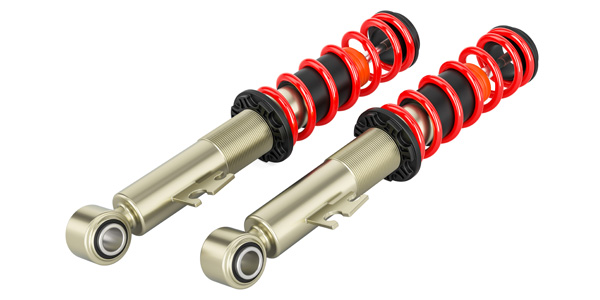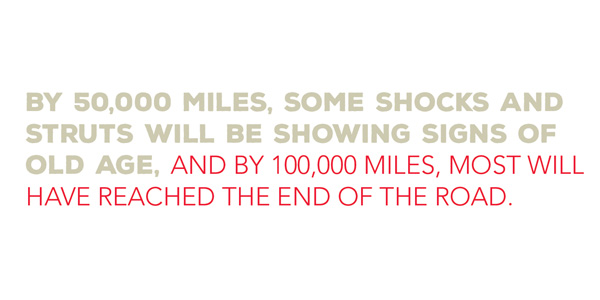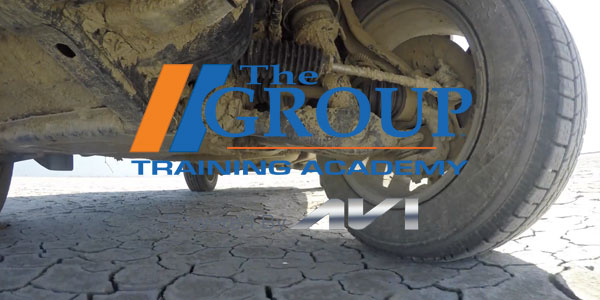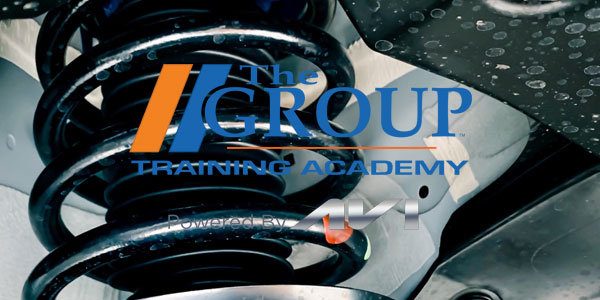
Unlike diamonds, dampers don’t last forever. They take quite a pounding that eventually wears out their internal valving and seals. Although relatively simple in design, they perform a very important role in the vehicle’s suspension.
Shocks and struts connect the movable parts of the suspension (the control arms or axles) to the vehicle’s unibody, subframe or frame. Every time the suspension experiences any kind of up-and-down motion (which is all the time while it is moving), the shocks and struts create a calibrated amount of resistance to dampen the motion.
The dampening action prevents the wheels from hopping and bouncing uncontrollably after hitting a bump or dip in the road. It prevents the body from swaying or leaning excessively when cornering or driving in strong crosswinds. It also helps offset the tendency to nosedive when braking hard. The end result is a vehicle that rides, steers, handles and brakes in a predictable, safe and controlled manner.
Shocks and struts convert the kinetic energy of motion into heat. When the piston rod inside a damper is pumped up and down, the piston displaces hydraulic fluid and forces it through small slots or orifices. Hydraulic fluid is actually incompressible (when it does not contain air bubbles), so the amount of resistance created by the pumping action is controlled by the valving inside the damper.
Spring-loaded valves are forced open by fluid pressure so the fluid can flow around the piston and/or into a secondary chamber (the outer fluid reservoir in a twintube shock or strut). Monotube shocks and struts have no outer tube, so a floating piston in the top of the damper pushes against a high-pressure nitrogen gas charge behind it to help dampen motions. High-pressure gas-charged shocks and struts typically are used in performance applications.

Most twintube shocks and struts also are gas pressurized, but at a much lower pressure to help reduce the formation of bubbles in the fluid. Fluid aeration and foaming can occur when the piston is pumping rapidly up and down. The foamy air/fluid mixture offers much less resistance, resulting in “shock fade” that noticeably reduces ride control on rough roads.
Some shocks and struts also play a key role in maintaining ride height. Nivomat shocks are a special type of damper found on many import applications. They have an internal pump-like mechanism that is self-leveling to compensate for changing loads and driving conditions. Air shocks are another design that provides the ability to control ride height. Air shocks have an external air bladder on top or an air spring that allows the shock to partially or fully support the weight of the vehicle as needed. Air shocks/springs are used on many luxury models and include an onboard compressor, control valves and height sensors to add or vent air as needed to maintain ride height. Such systems are vulnerable to air leaks in the plastic tubing, air bladders or air springs. Air leaks may cause the suspension to go flat or the compressor to overheat and fail.
Electronic dampers of various types are found on many late-model cars and SUVs. Such systems rely on sensor inputs (ride height, steering angle, vehicle speed, pitch and yaw, etc.) to improve handling and ride control. Many are very fast-acting and can respond to changes in driving dynamics in hundredths of a second. Problems with sensor inputs, wiring connections or the electric motors or solenoids inside the dampers can affect their operation and may set suspension trouble codes.
Unfortunately, there are no warning lights or trouble codes to alert the driver of a vehicle that has conventional shocks or struts if their dampers are failing or need to be replaced. One still has to visually inspect the dampers for leaks or damage, check the tires for signs of cupping or unusual wear, and/or perform an old-fashioned “bounce test” or test drive to see how the vehicle rides and handles.
By 50,000 miles, some shocks and struts will be showing signs of old age, and by 100,000 miles, most will have reached the end of the road. Yet many replacement sales are missed because the obvious signs of bad shocks/struts are often overlooked or ignored.
Shocks and struts always should be replaced in pairs (both front or both rear) or in complete sets (all four). Upgrades may be recommended depending on the application, and preassembled struts can make installation faster, easier and safer.












